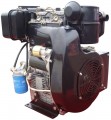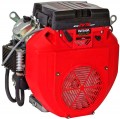Fuel
The fuel for which the engine is designed determines many features of its design and use.
—
Gasoline. Gasoline engines are relatively inexpensive and much easier to operate, maintain and repair than diesel engines, which makes them very popular. Their main disadvantage is the higher price of fuel.
—
Diesel. Diesel fuel (solar oil) is much cheaper than gasoline, which is considered one of the main advantages of this type of engine. In addition, they have good efficiency and low values of specific fuel consumption, and also provide higher torque at low speeds than gasoline of the same volume, making them well suited for heavy work. On the other hand, the motors themselves turn out to be quite expensive and difficult to operate, and powerful electric starters are required to start them. As a result, relatively few general purpose diesel engines are produced, mainly medium and high power units.
— Kerosene. Kerosene engines are similar in many characteristics and features to the gasoline engines described above (many models even require a small amount of gasoline to start). The main difference lies in the fuel used. Kerosene is somewhat cheaper than gasoline (when purchased in bulk), and if you need relatively little fuel, you can get it at almost any hardware and hardware store (this often turns out to be easier than going to a gas station for gasoline). With regard to performance, t
...he creators of kerosene engines often claim economical fuel consumption and suitability for long-term operation under heavy loads; however, this is due more to special design solutions than to the characteristics of the fuel used.Max. torque
The maximum torque developed by the engine during operation. Note that such an indicator is usually achieved only at certain speeds — this nuance can be specified in the characteristics.
Torque can be simplistically described as the force exerted by a motor on a shaft. The higher this effort, the more “high-torque” the motor is, the better it overcomes resistance and handles with high loads. The torque value is directly related to the power. For example, for 5 hp models. and less torque
up to 10 Nm is considered quite normal, engines of 4 – 7 hp. give out
from 10 to 20 Nm, and values
of 20 Nm or more are found in units with a power of at least 8 hp. At the same time, engines of the same power may differ in actual force. So this indicator characterizes the capabilities of the unit well in comparison with analogues.
It is worth saying that many consider torque to be a more reliable and visual parameter than power: the latter can be indicated in different ways (nominal, maximum, etc.), while torque is a completely unambiguous characteristic.
Shaft type
Shaft type, more precisely, the type of fastening for the hub provided on the shaft shank.
Recall that a hub is a part with a hole that is put on the shaft; it is through this part that the rotation is transmitted to the mechanism with which the engine is used. The general rule in this case is this: the type of shaft must match the type of mounting on the hub, otherwise normal operation will not be possible. Nowadays, there are units with shafts
under the key,
under the spline,
under the cone and
under the thread. Here is a more detailed description of each option:
— Dowel. Connection using a key — an elongated part placed in a special longitudinal groove. More precisely, there are two grooves: one is located on the shaft, the other is on the hub, and the key is tightly installed in the space formed by the grooves and connects the shaft and the hub. Such connections are simple and at the same time quite functional, due to which they are widespread and found in engines of all price and “weight” categories. On the other hand, a keyed connection is less secure than a splined connection and is less suitable for high RPM and/or heavy loads.
— Slots. Connection based on slots — longitudinal slots. Most often, there are six of them on the shaft, and the seat on the hub has the appropriate shape — in the form of a charac
...teristic asterisk. A spline connection is more complicated and more expensive than a keyed connection, and numerous slots reduces the strength of the shaft and it has to be made thicker. However, the connection itself is very reliable, as it evenly distributes the load during rotation. Therefore, splines are recommended for work at high loads.
— Cone. A shaft with a shank in the form of a cone (tapering towards the end), in the centre of which there is a hole with an internal thread. It is used quite rarely, mainly on fairly powerful units — from 7 hp. and higher.
— Carving. Cylindrical shank with external thread. A rather specific option that has not received much distribution — in particular, due to the fact that the thread tends to loosen from vibrations as it is used, and significant efforts may be required to connect and disconnect the shank and hub.Shaft diameter
The diameter of the motor shaft, more precisely, the diameter of its outer part, located behind the housing. Data on the diameter of the shaft is needed to clarify the compatibility of the engine with the mechanism for which it is bought.
Now on the market there are shafts with the following diameters:
16 mm,
19 mm,
20 mm,
22 mm,
25 mm.
Capacity
The working volume of all engine cylinders. Usually, other things being equal, a larger volume allows you to achieve higher power, but increases fuel consumption and affects the dimensions of the unit.
Number of cylinders
The number of cylinders in the engine. This parameter is selected by the manufacturer so that the working volume (see above) is optimally distributed between the individual cylinders. Therefore, in general, it is secondary, and when choosing, it is worth looking not so much at the number of cylinders as at the overall level of the engine and individual practically significant characteristics — primarily fuel, power and shaft location (see above). We only note that the larger the volume and the higher the power, the more cylinders can be provided.
Now on the market there are engines with the following number of cylinders:
1,
2,
3,
4,
6.
Piston diameter
The engine piston diameter is a reference parameter — in fact, this data is required very rarely, usually, for repairs and other specific tasks that the average user usually does not deal with at all.
Piston stroke
The distance that an engine piston travels from one extreme point to another. In general, it is a rather specific characteristic and is rarely required in fact (for most ordinary users, it is never needed at all in the entire “life” of the engine).
Fuel tank volume
The nominal volume of the engine's fuel tank is the maximum amount of fuel that can be safely filled there. Knowing the fuel consumption (see below), it is possible to estimate the operating time of the unit on a single refill by the volume of the tank by dividing the tank capacity by the consumption.
Large fuel tanks, on the one hand, allow you to work for a long time without refueling, on the other hand, they significantly affect the dimensions and weight of the engine. Also note that many models allow refueling "on the go." When choosing a tank volume, manufacturers take into account these points, as well as the “weight category” and the specifics of the engine application.

